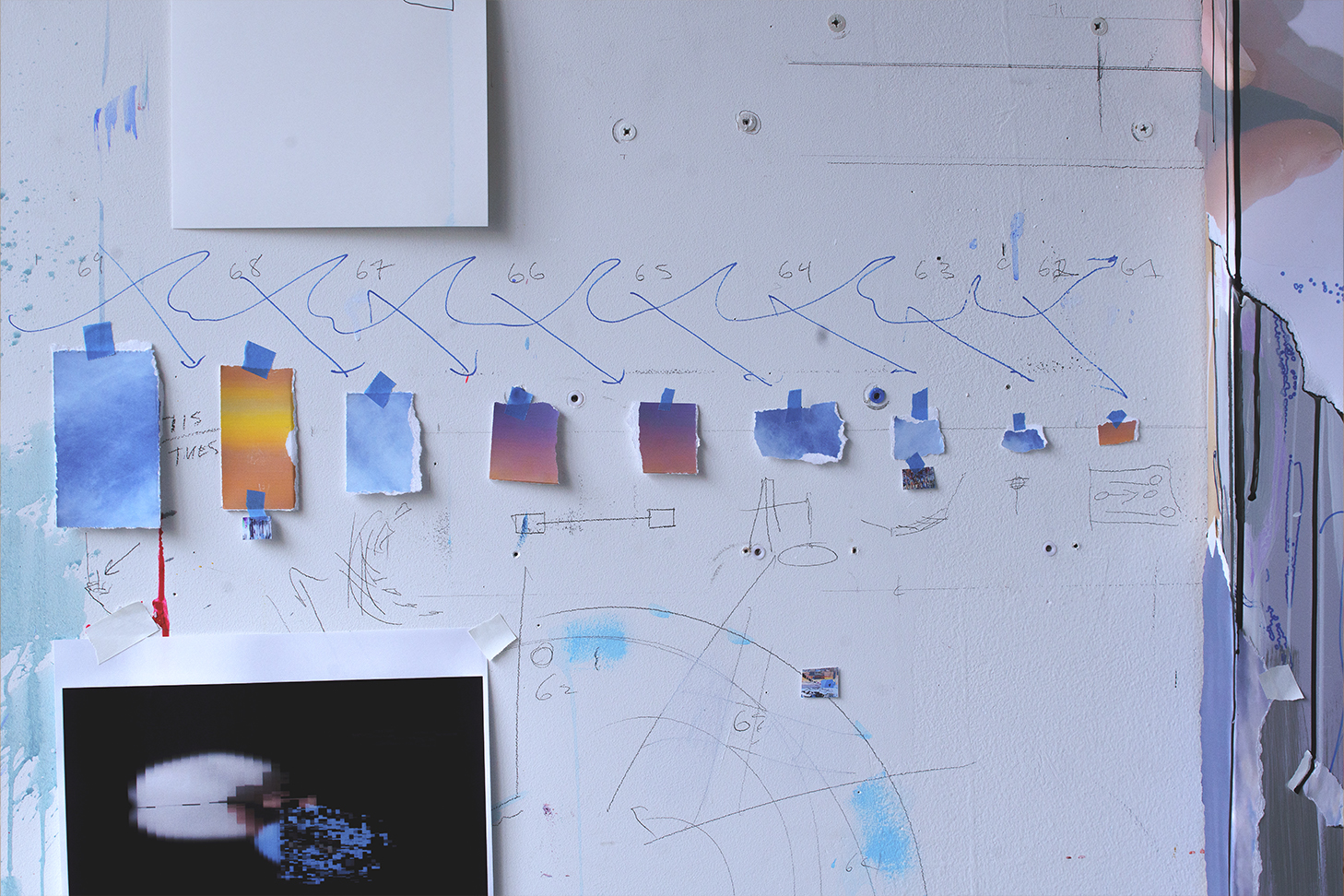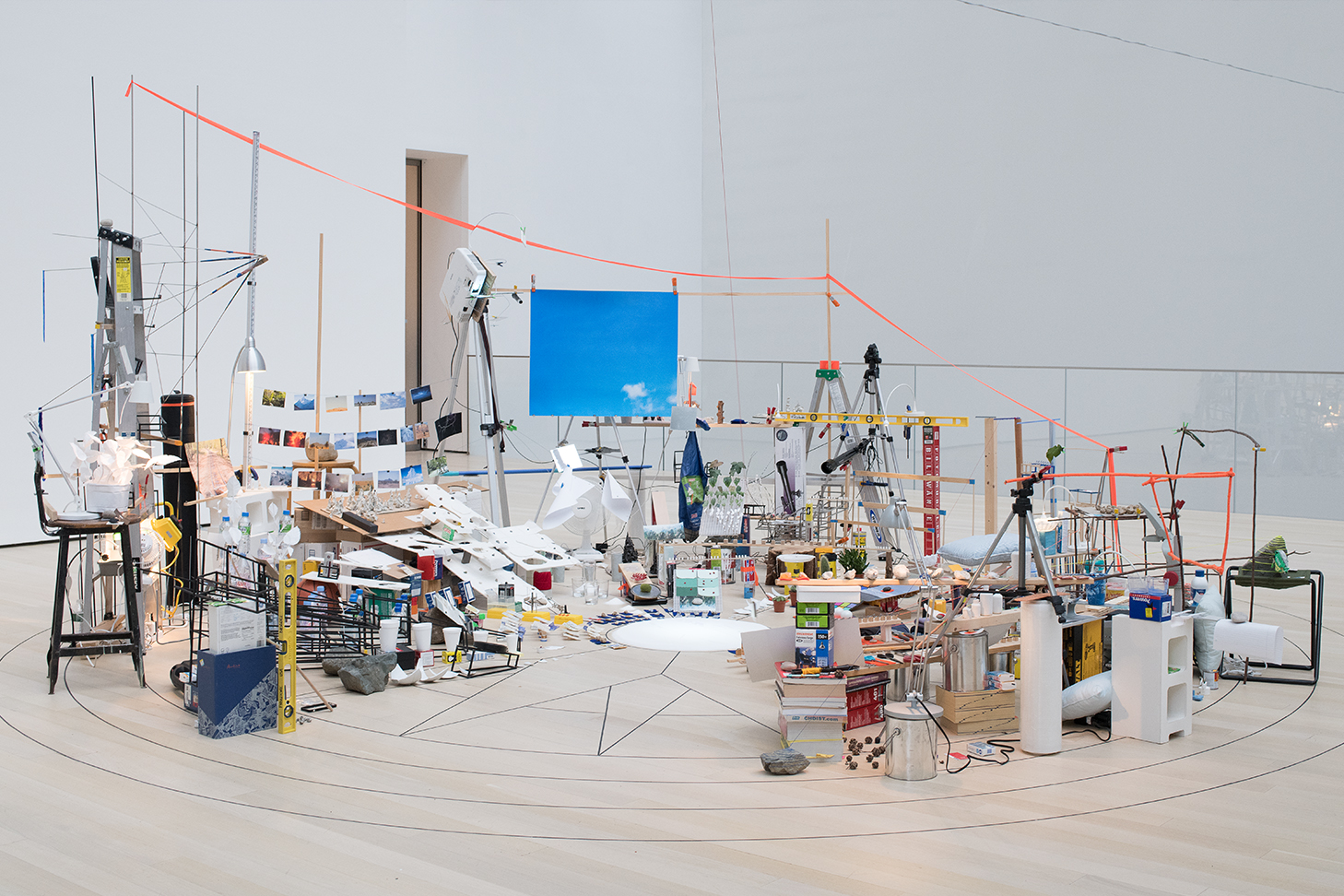
This is also true of the work of Sarah Sze. My first encounter with it occurred over 20 years ago. It was 2001. I was a curatorial assistant at the Dallas Museum of Art, in San Francisco installing at the Legion of Honor, a Henry Moore retrospective I had helped DMA curator Dorothy Kosinski organize. In a break from installing, I ventured downtown to SFMOMA where I encountered Sze’s Things Fall Apart (2001), a temporary work of art the museum had commissioned, which they later made permanent. It was as unlike a sculpture by Henry Moore as one could imagine. It enjoyed a pride of place of sorts, not standing solidly on the ground floor like a monumental Moore or floating ethereally from the ceiling like some grand Alexander Calder mobile, but cascading down several levels of the grand staircase. Its materials—a wild mélange of commonplace objects including parts of a car body, lamps, and strips of plastic and wood—were dispersed over two floors of stairwell landings and cantilevered out into the atrium, connected by taut strings, wires, and looping metal ribbons. The experience was at once grand in its engagement with the stairwell and atrium and intimate in the intricacy of details; mechanistic like an exploded diagram of another dimension yet organic in its dispersion; monumental in scope yet understated in its expression of scale. The fact that one could not understand the work in its entirety at a single glance, or even physically access all of it, but only glean information as one moved through the space and encountered it from different vantage points, only added to its mystery and dynamism. The work itself also seemed to be about time, evoking the slipstream vortex we sometimes experience in deja vú or premonitions, when it seems past and future connect in the present.
 Fast forward to 2016. Sze has exhibited widely, been named a MacArthur Foundation Fellow (2003), and represented the United States at the Venice Biennale (2013), and I’ve been curator at the Nasher for 13 years, when the Nasher and University of North Texas invite the artist to lecture at both institutions in 2016. I learn then that she communicates as cogently, expansively, and poetically in person as in her work. We have a conversation about possibly working together on an exhibition at the Nasher. Past and future converge in the present. Time passes. I meet the artist in New York at the Museum of Modern Art where one of her installations from Venice, Triple Point (Pendulum) (2013) is now in the collection and on view. We discuss ideas, consult calendars, and target dates for a presentation. Then, the COVID pandemic—a real-life experiment in warping time— reshapes everyone’s schedules and compels us to recognize how much we exchange direct experience for glimpses of the real world through our internet-enabled devices.
Fast forward to 2016. Sze has exhibited widely, been named a MacArthur Foundation Fellow (2003), and represented the United States at the Venice Biennale (2013), and I’ve been curator at the Nasher for 13 years, when the Nasher and University of North Texas invite the artist to lecture at both institutions in 2016. I learn then that she communicates as cogently, expansively, and poetically in person as in her work. We have a conversation about possibly working together on an exhibition at the Nasher. Past and future converge in the present. Time passes. I meet the artist in New York at the Museum of Modern Art where one of her installations from Venice, Triple Point (Pendulum) (2013) is now in the collection and on view. We discuss ideas, consult calendars, and target dates for a presentation. Then, the COVID pandemic—a real-life experiment in warping time— reshapes everyone’s schedules and compels us to recognize how much we exchange direct experience for glimpses of the real world through our internet-enabled devices.
This year, at the end of May, I saw Sze’s exhibition at the Solomon R. Guggenheim Museum in New York, Timelapse. The works there further honed her recent investigations, begun before the pandemic, of how the surfeit of imagery that inundates our daily lives shapes our experience of time and space. They incorporate both printed and projected imagery in ramshackle structures of materials that make up the artist’s everyday studio environment: wooden dowels, spring clamps, paper, string, paint, lamps, tape measures, and ladders, along with paintings, collages, and models of previous sculptures. The images define and dematerialize the structures, suffusing, caressing, and extending the works to the limits of the spaces that house them. Like many of Sze’s exhibitions, the work is conceived with the site in mind; collaborations with architecture are irresistible for Sze, a daughter of an architect and former architecture student herself. At the Guggenheim, the works occupy the uppermost loop of Frank Lloyd Wright’s spiral ramp, interconnected by a stream of projected imagery that flows through them all as well as a plumb bob on a string that runs through them, reaches up to the Art Deco skylight, and hangs down the base of the rotunda, skimming the water of the fountain at the bottom of the ramp.
Shortly after I visited the Guggenheim exhibition, Nasher Director Jeremy Strick was in London where Sze had created an installation for the Artangel Trust at Peckham Rye Station in a waiting room that had been abandoned for 50 years. He texted me a short video of the experience. Even flattened on my iPhone screen, the installation, The Waiting Room (2023), was operatic, as if all the sublime beauty of the world had been secreted away in a disused room in a 19th century London train station and quietly opened decades later to remind us of the glories of the world beyond its walls.
Next January, Sze will install new work in the Renzo Piano-designed spaces at the Nasher Sculpture Center. With each new opportunity, Sze builds on the previous ones. Although the installations are meticulously planned, the artist always leaves room for responding to the space and the circumstances in the moment. I can’t wait to see what transpires this time.
IMAGES, TOP: Sarah Sze. Studio images, 2023. Images courtesy of the artist
LEFT SIDE SOLO: Sarah Sze (b. 1969). Triple Point (Pendulum), 2013. Salt, water, stone, string, projector, video, pendulum and other materials. Dimensions variable, approximately 150 x 210 x 200 inches (381 x 533.4 x 508 cm). Museum of Modern Art. Image courtesy of the artist.
LEFT SIDE: Sarah Sze. Studio Image, 2023. Images courtesy of the artist
RIGHT SIDE: Sarah Sze (b. 1969). Things Fall Apart, 2001. Mixed media installation with vehicle, dimensions variable. SFMOMA. Images courtesy of the artist
MIDDLE: Sarah Sze, Metronome, 2023. "The Waiting Room," Peckham Rye Station, London. Commissioned by Artangel. Photo: Thierry Bal
BOTTOM: Sarah Sze (b. 1969). The Night Sky is Dark Despite the Vast Number of Stars in the Universe, 2023. Acrylic, string, paracord and wood. 176 x 180 x 41 1/2 inches (447 x 457.2 x 104.1 cm). Images courtesy of the artist